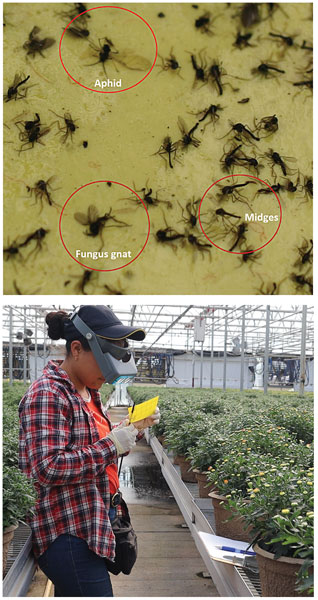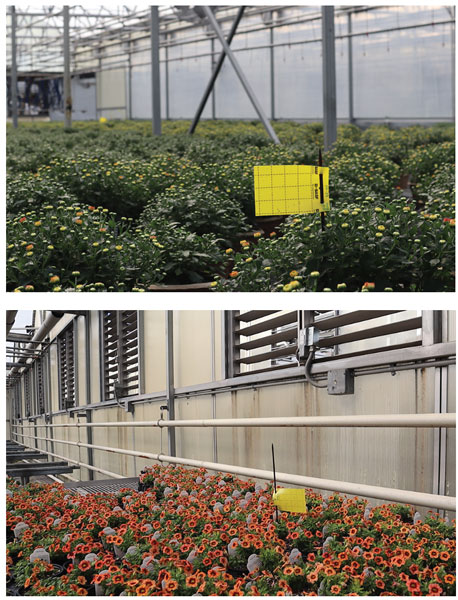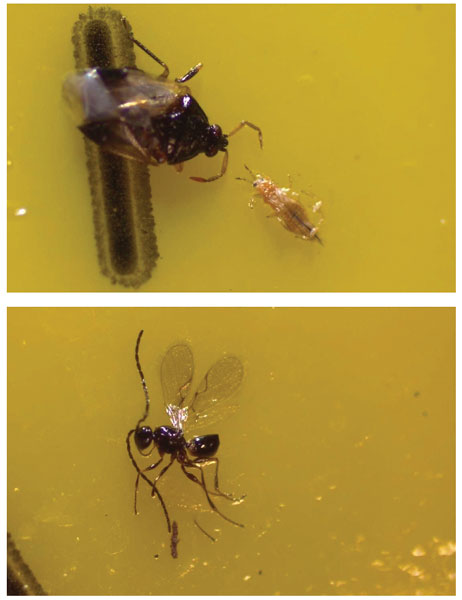2/1/2024
A Sticky Subject
Leanne Pundt, Rosa E. Raudales & Carla Caballero
 Sticky cards are an important tool for early detection of pests and an important component of an effective scouting program. They can only trap winged insect pests like thrips, whiteflies, fungus gnats, leafminers, leafhoppers, shore flies and winged aphids (Figure 1). Random plant inspections are still needed to scout for non-winged pests or stages, such as immature whitefly nymphs, thrips larvae, spider mites, broad mites, scale insects, wingless aphids and mealybugs crawlers.
Sticky cards are an important tool for early detection of pests and an important component of an effective scouting program. They can only trap winged insect pests like thrips, whiteflies, fungus gnats, leafminers, leafhoppers, shore flies and winged aphids (Figure 1). Random plant inspections are still needed to scout for non-winged pests or stages, such as immature whitefly nymphs, thrips larvae, spider mites, broad mites, scale insects, wingless aphids and mealybugs crawlers.
Figure 1. Winged insects trapped on a sticky card.
Figure 2. Employee monitoring a sticky card.
Blue sticky cards may be more attractive to thrips and shoreflies, however, yellow cards are best for general monitoring.
Tips for using sticky cards
■ Inspect the cards regularly in combination with plant inspections to detect pest outbreaks early and allow for prompt action (Figure 2). Most greenhouse growers use 3 in. x 5 in. sticky cards. Change the cards weekly.
■ Place cards just above the plant canopy (Figure 3). Use three to four cards per 1,000 sq. ft. or a minimum of one card per 1,000 sq. ft. with additional cards placed near entrances, vents, sidewalls and areas where pests are likely to enter the greenhouse (Figure 4). You can also place extra cards over especially problem-prone species or cultivars.
■ As more growers are using biological controls, the use of sticky cards needs to be adjusted. Many biological control agents (BCAs) have a winged stage that can be caught on the cards (Figures 5 and 6). Make sure the sticky cards aren’t up the evening you’re releasing winged BCAs. Wait one or two days before putting the cards up again. Talk with the biological control supplier to get suggestions on the use of sticky cards with the specific BCAs you use.
■ As an example, growers producing poinsettias typically release Eretomocerus sp. or Encarisa formosa, the host specific parasitic wasps for whiteflies. These growers may prefer that more of the employee’s scouting time is spent inspecting poinsettias for whitefly nymphs, signs of parasitism and host feeding by the parasitic wasps being released. Therefore, they may decide to reduce the number of sticky cards placed around the greenhouse.
 Figure 3. Place cards just above the plant canopy.
Figure 3. Place cards just above the plant canopy.
Figure 4. Place sticky cards where pests are likely to enter, such as near vents.
Training and retraining the staff every season is also an important part of effective integrated crop management. Prevention is key when it comes to managing pests in the greenhouse. By integrating sticky cards into the scouting program, we can better detect pest problems early resulting in better management. GT
This article was originally published in the August 2023 e-Gro Alert newsletter.
Watch the instructional video for proper card utilization and identification of the common insect pests caught on the sticky cards HERE. For a Spanish version, go HERE.
 Leanne Pundt, Rosa E. Raudales and Carla Caballero are all with the University of Connecticut.
Leanne Pundt, Rosa E. Raudales and Carla Caballero are all with the University of Connecticut.
Figure 5. Insidious flower bug trapped on a sticky card.
Figure 6. Parasitic wasp trapped on a sticky card.